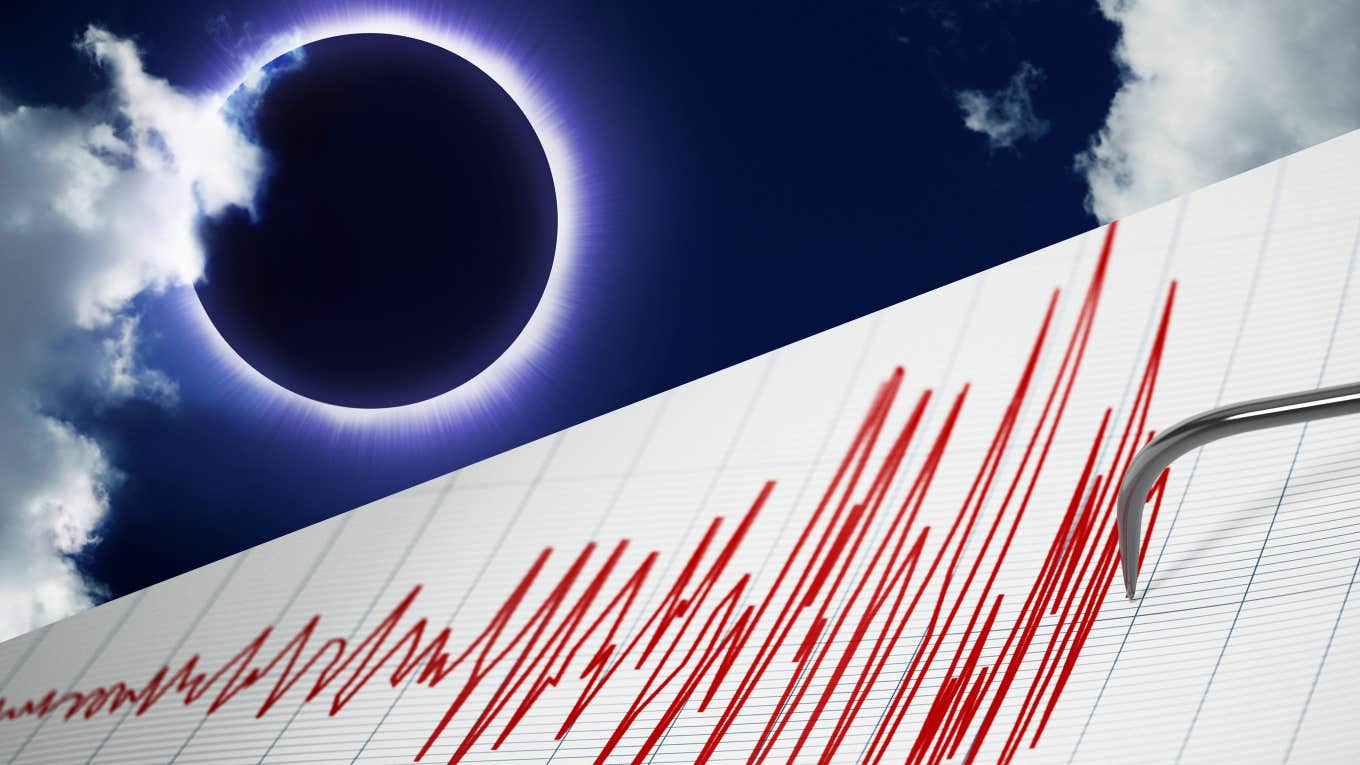Theory Claims The Total Solar Eclipses That Crossed The US ‘Mark The Spot’ Where The Country Will Get Hit With A ‘Catastrophic’ Earthquake
There may not be any scientific basis for the theory, but the spot does have a long history of enormous quakes.
 PepeLaguarda | adventtr | Getty Images Signature | Canva Pro
PepeLaguarda | adventtr | Getty Images Signature | Canva Pro Back in April, it was all anyone talked about for days: the total solar eclipse that was visible through a small swathe of the United States stretching from Texas to Maine.
Because we live in deeply (and terrifyingly) conspiratorial times, the eclipse brought with it all kinds of insane theories. Among them was one that centered on the geographic point along the Mississippi River where the 2024 eclipse and the 2017 eclipse overlapped. It turns out that this point is a pretty storied place in America's history with, of all things, earthquakes.
The theory states that the point where the eclipses crossed 'marks the spot' for the next big earthquake.
Earthquakes are certainly nothing unique in the United States. California is famous for them, and the entire Western United States is riddled with faults, including the Pacific Northwest's Cascadia Subduction Zone, which will one day produce a quake that will make California's San Andreas look like child's play.
And while earthquakes do happen in all kinds of unexpected places in the U.S. — there was one in New Jersey of all places just days before the eclipse — the middle of the country along the Mississippi River isn't exactly "earthquake country."
So, at first blush, this theory about the eclipses seems absurd. The path of totality for the August 21, 2017, eclipse ran diagonally from Oregon to South Carolina, while April 8, 2024, ran from Texas to Maine, meaning the two paths intersected right along the Illinois-Missouri border.
But it turns out that area is, in fact, one of America's many earthquake ground zeroes. The mysterious happenings right before the 2024 eclipse did little to dispel the theory.
The eclipse paths intersected near New Madrid, Missouri, home of one of America's lesser-known but most active seismic zones.
Now, before we go any further, the eclipse paths didn't actually intersect at New Madrid, Missouri; they intersected at Carbondale, Illinois, more than 90 miles away.
Though research has found that eclipses' extra tidal stress might make quakes slightly more likely, the two have almost nothing to do with each other. The only people who seem to believe they're related also believe they're a form of God's wrath — like the many Christians who said the April 8, 2024 eclipse would bring about the Rapture, which did not happen.
What did happen, oddly enough, was a swarm of about five small earthquakes in the New Madrid seismic zone on April 5, 2024, three days before the eclipse and, even stranger, the same day as the 4.8 earthquake that hit New Jersey. Eerie!
It's not uncommon, however, for the New Madrid seismic zone to do this. Intraplate earthquakes, small ones that occur within tectonic plates themselves, happen there all the time, rarely with enough intensity to be felt by the millions of people living in the area. But that is all but certain not to be the case forever.
The New Madrid Fault Zone has a long, legendary history of catastrophic earthquakes—and seismologists say it's overdue for a big one.
America is known worldwide for its legendary earthquakes, especially the 1964 Alaska earthquake near Anchorage — the strongest ever recorded in the U.S. at 9.2 on the Richter scale — as well as the catastrophic 7.9 San Francisco earthquake in 1906 that all but leveled the budding metropolis.
But in the 1800s, the New Madrid Fault Zone was giving California a run for its money when, out of nowhere, it suddenly woke up and produced a series of horrifying earthquakes over the course of a few weeks in 1811 and 1812.
It began on December 16, 1811, with a quake between 7.9 and 8.2, followed by a 7.2 aftershock later that day, and another measuring between 7 and 8 weeks later on January 23, 1812.
On February 7, 1812, came "The Big One" of its day: a quake ranging from 7.4 to 8.2, which destroyed the town of New Madrid. The shaking was so strong that it made the Mississippi River appear to flow backwards, which only added to the panic. Even St. Louis, more than 150 miles north, was damaged, and it was felt all the way in New Orleans and Charleston.
For context, all of those earthquakes were orders of magnitude stronger than legendary ones like San Francisco's 6.9 Loma Prieta, which famously interrupted the 1989 World Series on live TV, and 1994's 6.7 Northridge earthquake in Los Angeles, which is to this day the costliest earthquake in U.S. history.
U.S. Geological Survey scientists say there is only about a 10% chance of a repeat of the 1811-1812 earthquakes in the next 50 years, and paleoseismic studies have found that while New Madrid has produced enormous earthquakes as far back as 900 A.D., they tend to only happen every 500 years or so.
Still, the USGS says there's a 25-40% chance of a smaller but still catastrophic earthquake of 6.0 or greater in the New Madrid Fault Zone within the next 50 years, so it's surely only a matter of time before people see the Mississippi flow backward again.
Maybe it'll happen during the next eclipse, just to keep people guessing.
John Sundholm is a news and entertainment writer who covers pop culture, social justice, and human interest topics.

